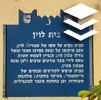The sign shape is square but its head is designed according to the silhouette of the old building of the Gymnasia Herzliya, which serves as a logo of the Council for the Preservation of Heritage Sites in Israel
The place was photographed that day by the same photographer
 Click for a larger image
Click for a larger image The site has additional signs from the same place
 Click for sign's details Translation of the text on the sign
Click for sign's details Translation of the text on the sign:
Symbol of the Council for the Preservation of Israeli Heritage Sites
The symbol of the Minkov Orchard Site
Symbol of the Ministry of Education, Culture and Sports
Emblem of the city of Rehovot
The orchard site named after Minkov "Pardes Rishonim" was planted in 1904 by Zalman Minkov, the pioneers of orchards in the Rehovot colony. The courtyard buildings were also erected during his time.
Zalman Minkov believed in Hebrew labor and contributed to the establishment of the Hebrew workers in the colony. The principle of Hebrew labor was preserved when the orchard passed to Shmuel Tolkowski and then to Shmuel Gothilf.
Pardes Minkov was a center for the workers of the Second Aliyah, and over the years well-known people worked there, such as: Yosef Aharonovich Ben-Zion Israeli, the poet Rachel and members of Hashomer.
Formed the background for Moshe Smilansky’s book "In the Shadow of the Orchards", and for the story "Washing in the Pool" by the author S. Yizhar.
Eventually the orchard was abandoned, at the initiative of members of the Society for the Protection of Nature in the city of Rehovot and the Council for the Preservation of Buildings and Settlement Sites, began restoring the site.
The site is being restored and operated by the Sites Preservation Council, in collaboration with the Rehovot Municipality, as part of the restoration of 50 heritage and revitalization sites.
Symbol of the Jewish National Fund
Symbol of the Society for the Protection of Nature

 Click for a larger image
Click for a larger image  Click for sign's details
Click for sign's details  Click for all signs belonging to Heritage Sites in Israel
Click for all signs belonging to Heritage Sites in Israel
 676 Meter |
676 Meter |  676 Meter |
676 Meter |  713 Meter |
713 Meter |  715 Meter |
715 Meter |  718 Meter
718 Meter